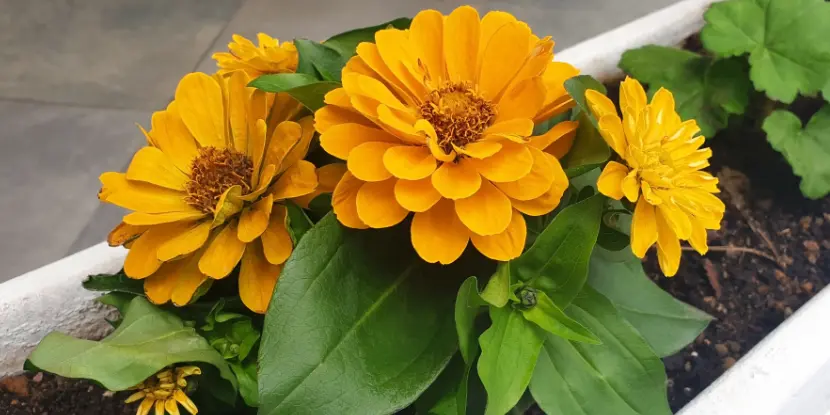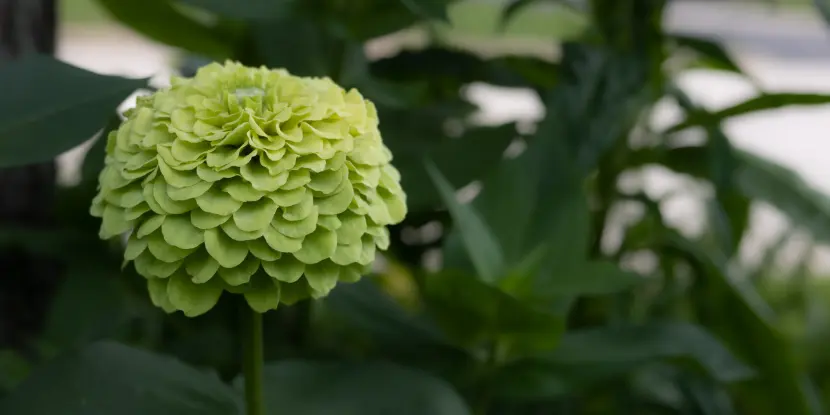The Aztecs gave us words like “chocolate,” “tomato,” and “avocado.”
They developed chinampas, or floating gardens, to feed their large population.
And they were the first to cultivate zinnias, a flower they called “eyesoredue” due to their often garish color, and which the Spanish translated as mal de ojos.
Zinnias originated in Mexico, but their name derives from an 18th-century German botanist, Johann Gottfried Zinn.
They grow rapidly and reliably from seed or transplants and need little care (almost like weeds!). They flourish in containers, excel in cut flower arrangements, and attract pollinator insects for the benefit of all garden plants.

Zinnia angustifolia, the Narrowleaf Zinnia, is native to northern and western Mexico.
Choosing Your Zinnia Seeds
Zinnias are annual flowers that complete their life cycle in a single growing season. They possess a remarkable ability to reseed themselves.
This natural reseeding allows for the glorious yearly return of zinnias in your garden without additional planting.
However, at the outset, you’ll need seeds or seedlings, which fall into three broad categories.
- Dwarf zinnias: Ideal for borders or container gardens, these varieties stay compact and reach heights of 6–12 inches.
- Medium zinnias: Great for filling garden beds, they grow between 12 and 24 inches tall.
- Tall zinnias: These striking accent flowers can reach 3–4 feet.
Popular zinnia varieties include:
- Zinnia elegans: Known for its wide range of colors and large blooms.
- Zinnia angustifolia: A ground-cover plant with smaller, daisy-like flowers.
- Zinnia haageana: Also called Mexican zinnias, their showy bi-colored petals are impossible to ignore.
Consider the color, height, and flower type you desire. Don’t hesitate to mix and match different varieties for a stunning and memorable zinnia garden. Always purchase seeds or seedlings from a reputable source.

The showy, bi-colored blossoms of Mexican Zinnia (Zinnia haageana).
Planting Your Zinnia Seeds
Zinnias prefer full sun and well-draining soil.
Sow the seeds directly into the ground after all danger of frost has passed.
You can also start them indoors 4–6 weeks before the last frost and transplant them outside when the weather warms.
Soil Preparation
- Clear the area of any weeds or debris to give your zinnias a clean start.
- Loosen the soil with a rake or shovel to prepare your planting area.
- Add a generous amount of organic compost to enrich the soil. This will also improve soil texture and moisture retention.
- Level the soil and lightly tamp it down.
Sowing the Seeds
- Follow the instructions on your seed packet for the recommended spacing between seeds and rows.
- Plant the seeds 1/4 inch deep in groups of 4–6, as this increases pollination rates.
- Gently cover the seeds with soil and press down lightly to ensure good contact between seed and soil.
- Water thoroughly but gently without disturbing the newly planted seeds.
- Keep the area moist until germination occurs, usually within 7–10 days.

The smaller zinnia varieties make excellent border plants,
Starting Indoors
To get a head start on the growing season, you can start zinnia seeds indoors about 4 to 6 weeks before the last frost date. Use seed trays or small pots filled with seed-starting mix.
- Plant the seeds 1/4 inch deep and keep the soil consistently moist.
- Place the trays under grow lights or near a sunny window to ensure they get enough light.
- Before transplanting the seedlings outdoors, harden them off by gradually exposing them to outdoor conditions for a week.
Caring for Your Zinnias
Watering Tips
While zinnias are drought-tolerant, they appreciate regular watering, especially during dry spells.
- Give your zinnias a deep watering once a week rather than frequent shallow watering. This encourages strong root development.
- To prevent diseases, water at the base of the plants rather than overhead, keeping the foliage dry.
Fertilizing for Blooms
- Applying balanced fertilizer once or twice during the growing season will encourage more blooms.
- Too much nitrogen can result in lush foliage at the expense of flowers, so avoid high-nitrogen fertilizers.

Multicolored zinnias in a garden.
Pruning & Deadheading
Practice regular pruning and deadheading to keep your zinnias looking their best and promote continuous blooming.
- Deadheading: Remove spent flowers by cutting them back to the nearest set of leaves. This prevents seed formation and feeds new blooms.
- Pruning: If your zinnias become leggy, trim the stems by one-third for bushier growth.
Dealing with Pests & Diseases
Common Pests
Zinnias are generally resistant to pests but not immune. Here’s how to deal with unwanted critters:
- Aphids: These tiny insects can cluster on new growth. To control them, use insecticidal soap or a strong blast of water.
- Spider Mites: Look for miniature webs on the underside of leaves. To manage infestations, increase humidity around plants or use neem oil.
- Caterpillars: Handpick caterpillars or use biological controls like Bacillus thuringiensis (Bt).
Diseases
- Powdery Mildew: This fungal disease appears as white powdery spots on leaves. Avoid overhead watering and ensure good air circulation by spacing plants.
- Leaf Spot: Keep foliage dry and remove infected leaves promptly.

A delicate lime green Zinnia elegans, also called Benary’s Giant Lime.
Maximizing Your Zinnia Blooms
Succession Planting
Consider sowing seeds every 2 to 3 weeks for a continuous display of fresh blooms the entire season. This technique also helps you replace plants that may have succumbed to disease or pests.
Companion Planting
Zinnias are a superstar companion plant, attracting pollinators and beneficial insects. Try pairing zinnias with:
- Marigolds: Deter nematodes and add bright colors to the garden.
- Tomatoes and Peppers: Zinnias attract pollinators that increase fruit set.
- Cucumbers and Radishes: Zinnias offer natural pest control while creating a vibrant visual contrast.

Blooming zinnias carpeting a field in Japan.
FAQs: Zinnia Care
Q: Can zinnias be grown in containers?
Zinnias thrive in containers as long as they have enough sunlight and a well-draining potting mix. Choose dwarf varieties for the best results.
Q: How long do zinnias take to bloom?
Zinnias typically bloom 60 to 70 days after planting, depending on the variety and growing conditions.
Q: Can I save seeds from my zinnias for next year?
Yes. Allow some flowers to mature fully on the plant, then collect the seeds once they’re dry and store them in a cool, dry place for next season.
Q: Why are my zinnias not blooming?
This could be due to insufficient sunlight, poor soil, or over-fertilization. Evaluate your growing conditions and make adjustments as needed.
Q: Do zinnias attract butterflies?
Zinnias are known for attracting butterflies and other pollinators, making them an excellent choice for a pollinator-friendly garden.
Q: What is the best time to plant zinnias?
The best time to plant zinnias is after the last frost date in your area. They thrive in warm conditions. Aim to sow seeds or transplant seedlings when soil temperatures reach at least 60°F (16°C).
Q: How can I prevent zinnia disease?
Spacing the plants adequately to ensure good air circulation. Avoid overhead watering and remove any infected leaves promptly.
Q: Is it necessary to support tall zinnia varieties?
Though zinnias are sturdy, taller varieties may benefit from additional support, especially in windy conditions. You can use stakes or plant them among other sturdy plants for natural support.

